Question
Introduction: While it is good to move your body, you want to follow Physiotherapist Gray Cooks advice: first move well, and then move often. If
Introduction:
While it is good to move your body, you want to follow Physiotherapist Gray Cook’s advice: first move well, and then move often. If your body has issues with mobility, stability, strength and movement quality, you have an increased risk of injury from exercising, sports, recreational activities and/or manual labor. This lab will allow you to examine how your body is currently working and help you identify any issues you might need to work on. It will allow you to personalize your fitness program by knowing which areas needs mobility work and which need strengthening or coordinating work.
Part 1 I Assessment
A. Beighton Hypermobility Screen – click HERE to see pictures of each position: Chart 1
| Area | Position (Scoring: 1 point if you can do it, 0 if you cannot do it) | Raw Score | Final Score | |
| Right | Left | |||
| Little finger | Pulls back 90° | | | |
| Thumb | Touches forearm | | | |
| Elbow | Hyperextension ≥ 10° | | | |
| Knee | Hyperextension ≥ 10° | | | |
| Low back | Standing knees straight, palms flat on floor (1pt) | | | |
| Total Score | | |||
Scoring notes: Final score = sum of right & left scores, 5+ = hypermobility warning
B. Flexibility and Functional Movement Tests- see scoring rubric below
| Functional Test | Rationale, Directions & Scoring | Ares to Mobilize | Areas to Strengthen/ Coordinate |
Pencil Test 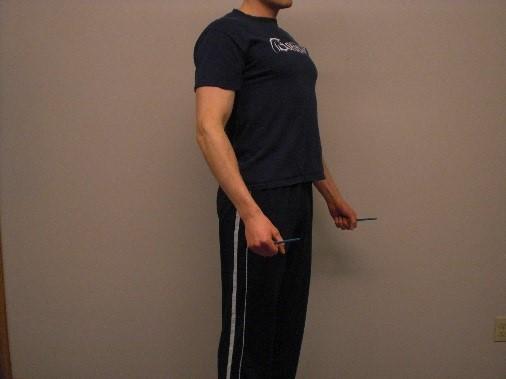 | Rationale: This test looks for imbalances between the muscles that rotate your arms in and those that rotate them out. If your shoulders are rounded forward, you will also have trouble with this test. Those who spend a lot of time with their computers/phones and those who spend too much time training the “mirror” muscles will not like this test. Directions: Hold a pen or pencil in each hand. Raise your arms straight from your sides until you hit shoulder height. Then relax and return your arms to their normal position. Note the directions of the pencil you’re your arms are in the position shown. Scoring: 3: pencil is pointed straight ahead 2: slight internal rotation 1: significant internal rotation Note: score each side separately and compare the results. | Internal rotators (Pectoralis major Latissimus Dorsi Teres major and Supscapularis) | External rotators (Teres minor Infraspinatus) Scapular retractors (Rhomboids and Middle Trapezius) |
Pelvic Tilt  | Rationale: Because of its central location, pelvic alignment is critical for optimal function. Poor alignment of your pelvis can lead to problems with in your low back, abdomen, hips, legs, knees, shins and feet. Directions: Tuck your shirt in and hike your pants up to your true waist. Stand sideways and take a picture, look in a mirror or have a partner have a look at your waistline. Scoring: 3: waistline is parallel to the ground 2: waistline is tilted slightly down to the front 1: waistline is tilted significantly down to the front | Hip flexors & Front Thigh (Psoas, Illiacus & Rectus Femoris) | Glutes Hamstrings Abs |
Knee to Wall (Ankle Mobility) 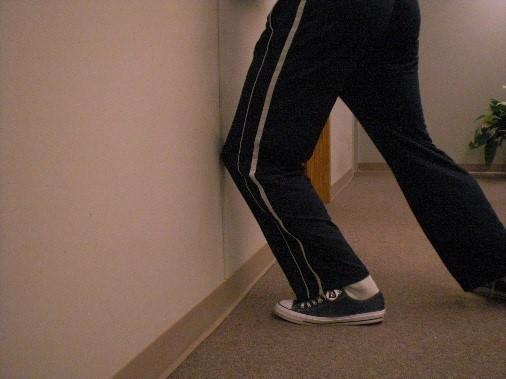 | Rationale: If your body lacks range of motion at one joint, it will make it up somewhere else. This test assesses your ankle forward bending (dorsiflexion) ability. If your ankle lacks mobility here, your body has to make up this range of motion at the knee – which increases your risk for knee injuries. Directions: Stand with your toes touching the wall. Move your knee forward to see if you can touch the wall with your knee. If so, slide your foot back 1” and repeat this process until you can no longer touch the wall without compensating (heel lifts up, knee comes in or foot spins out) Scoring: 3: Knee can touch the wall when toes are 4” from wall 2: Knee can touch the wall when toes are 2-3” from wall 1: Knee cannot touch the wall when toes are <2” from wall 0: this test caused pain | Ankles | |
Toe Touch 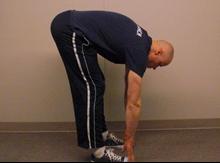 | Rationale: Your ability to touch your toes indicates proper movement (posterior weight shift), that your hamstrings are not guarding against instability and that you have adequate low back mobility. Directions: stand tall and keep your knees straight (they don’t have to be completely locked). Shift your hips back and bend over as far as you comfortably can. Scoring: 3: You can touch your toes 1: You cannot touch your toes 0: this test caused pain | | Toe Touch Pattern Core activation |
Shoulder Flexion 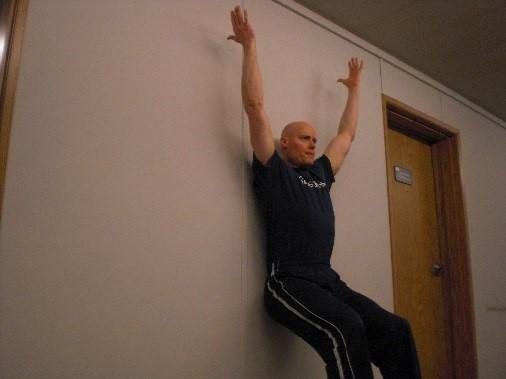 | Rationale: This test looks at your ability to get your arms overhead. This is important for sports, activities and exercises that require overhead positions. This range of motion is also important for maintaining healthy shoulder joints and a happy low back. Directions: Lean up against a wall with your feet about 1 foot from the wall. Keep your elbows locked and slowly raise your arms overhead while keeping your elbows locked, your low back from arching and your ribs from flaring. Scoring: 3: Touch thumbs to wall without compensation 1: Cannot touch thumbs to wall without compensation 0: This test causes pain | T-Spine Extension Lat & Shoulder Flexibility | |
Behind the Back Touch 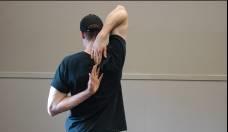 | Rationale: This test looks at the mobility of not only your shoulders but also the extension and rotation of your t-spine (upper back). Directions: With one elbow up and the other down, try to touch your fingers together behind your back. Scoring 3: fingers touch 2: fingers within 2” 1: fingers >2” apart 0: this test caused pain Note: score each side separately (note: right side is when the right elbow is up) and compare the results. | T-spine extension and rotation Shoulder Muscles? (Latissimus Dorsi, Triceps, Pecs, External rotators) | |
Hamstring Flexibility 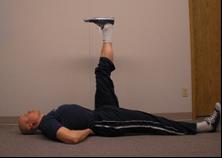 | Rationale: When most people test hamstring flexibility, they use tests like the sit and reach. The problem with this test is that you do not differentiate between hamstring flexibility and low back flexibility. This test focuses on your hamstring flexibility independent of your low back. Directions: Lie on the ground. Place your hands or your partner’s hand under your low back. Slowly lift your leg (or have your partner lift your leg) to see how high you can go. Stop the leg as soon as you feel your low back push on your hands (or your partner feels your back pushing on their hand). Scoring: 3: leg 85-90° from the floor 2: leg 84-60° from the floor 1: leg <59° from the floor | Hamstrings | |
Cook Hip Lift 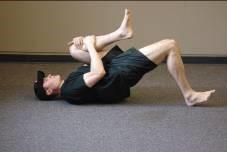 | Rationale: This test looks both at your mobility in your hip flexors as well as the strength and coordination of your glutes. Directions: Lie on back with knees bent to ~90° and feet flat on the floor. Pull one knee to chest and hold a tennis ball with that thigh against the chest. Keep the head down and relaxed. Drive through with the heel and extend the hip as far as possible. Scoring: 3: able to achieve full hip extension (body straight from shoulder to knee) without losing the tennis ball or having the hamstring cramp. 2: almost to full hip extension without problems 1: major problems or far from full hip extension 0: this test causes pain Note: score each leg separately and compare the results | Hip flexors Rectus femoris (middle front thigh muscle) | Glutes |
Overhead Squat 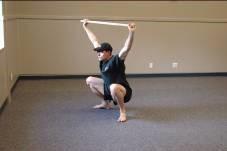 | Rationale: If I could only do one functional test, this would be it. To pass this test, one needs excellent mobility at the ankles, hips, t-spine and shoulders. It also requires excellent total body stability. Directions: Reach your arms overhead (you can also do this with a wooden dowel overhead as shown in the picture). Sit down into a deep squat as low as you can go while keeping your hands over your footprint (from side view) Scoring: 3: full squat (hamstrings to calves), without arms falling forward 2: almost full squat, arms forward just a bit of toes or arms a bit forward 1: not even close 0: this test caused pain | Ankles, hips, t-spine, shoulders | Core and body stability |
Abdominal Coordination 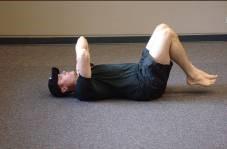 | Rationale: Your ab muscles’ job is to hold your spine in place while your arms and/or legs move. This test assesses the coordination of your abs to be able to do this. Directions: Lie on your back with arms crossed above the chin. Bend your knees and point them straight up. Have a partner place his/her hand (palm up) under your low back (at navel level). Press your back gently into your partner’s hand. Slowly lower your feet until they lightly touch the ground and then return to the starting position while maintaining consistent low back pressure on your partner’s hand. Scoring: 3: Feet go down to the floor and back up to the starting position while maintaining consistent lower back pressure 2: slight loss of low back pressure 1: significant loss of low back pressure 0: this test causes pain Note: the hardest points of this test are just as the feet are about to touch the ground and just as they begin to rise again. | | Abdominal stability and coordination |
Flexibility and Functional Movement Scoring Rubric : Chart #2
| Functional Test | Right Side Score | Left Side Score | Score | Comments |
| Pencil Test | | | | |
| Pelvic Tilt | | | | |
| Knee to Wall (Ankle) | | | | |
| Toe Touch | | | | |
| Shoulder Flexion | | | | |
| Behind the Back Touch | | | | |
| Hamstring Flexibility | | | | |
| Cook Hip Lift | | | | |
| Overhead Squat | | | | |
| Abdominal Coordination | | | | |
| Total: | | | | |
Results & Action Plan:
If any of these movements caused pain, be sure to check with your doctor
3’s: great! Just check from time to time
2’s: may want to work on it
1’s: high priority to address
Part 2 I Application Assignment
Based on the posture assessment and the evaluation of flexibility and function, make a master list of all the muscles you need to mobilize and strengthen/coordinate (i.e. 1 and 2 scores). Copy and paste the corresponding muscles into the appropriate columns below in chart #3. Make sure to record which side of the body needed more attention if you only have low score on one side. Work on these areas/issues in your fitness and corrective exercise program. (Ask for help as needed).
Example: Let’s say you scored a 1 on each side of the pencil test. For “Areas to Mobilize”, you would list: internal rotators. For “Areas to Strengthen/Coordinate”, you would list: external rotators and scapula retractors.
Areas to Mobilize/Strengthen/Coordinate chart : chart #3
| Areas to Mobilize | Areas to Strengthen/Coordinate |
| | |
Corrective Program Application
List one area that you need to work on based on part see Chart #3: Give at least 2 exercise (from Part #3 the list above) to address each area you need to work on. Chart #4
| List one area to mobilize or strengthen See chart #3 | Areas of Corrective Program | List two items in each category that can correct for your specific challenges |
| | 1. Lifestyle modifications | |
| 2. Corrective Exercises | | |
| 3. Exercise Modifications | |
H cally
Step by Step Solution
3.36 Rating (162 Votes )
There are 3 Steps involved in it
Step: 1
Sports physiotherapy Sports physiotherapy is a special branch of physioth...
Get Instant Access to Expert-Tailored Solutions
See step-by-step solutions with expert insights and AI powered tools for academic success
Step: 2

Step: 3

Ace Your Homework with AI
Get the answers you need in no time with our AI-driven, step-by-step assistance
Get Started


